Optimal Orientation and Tilt Angle for Maximizing in-Plane Solar Irradiation for PV Applications in Japan
Abstract
1. Introduction
2. Materials and Methods
2.1. Data Collection
2.2. Transposition Model to Convert Horizontal Irradiance to Tilted Irradiance
2.3. Determining the Optimal Orientation and Tilt Angle
3. Results
4. Conclusions
Author Contributions
Funding
Conflicts of Interest
References
- Inoue, M.; Genchi, Y.; Kudoh, Y. Evaluating the Potential of Variable Renewable Energy for a Balanced Isolated Grid: A Japanese Case Study. Sustainability 2017, 9, 119. [Google Scholar] [CrossRef]
- Pourgharibshahi, H.; Abdolzadeh, M.; Fadaeinedjad, R. Verification of Computational Optimum Tilt Angles of a Photovoltaic Module Using an Experimental Photovoltaic System. Environ. Prog. Sustain. Energy 2015, 34, 1156–1165. [Google Scholar] [CrossRef]
- Zang, H.; Guo, M.; Wei, Z.; Sun, G. Determination of the Optimal Tilt Angle of Solar Collectors for Different Climates of China. Sustainability 2016, 8, 654. [Google Scholar] [CrossRef]
- Guo, M.; Zang, H.; Gao, S.; Chen, T.; Xiao, J.; Cheng, L.; Wei, Z.; Sun, G. Optimal Tilt Angle and Orientation of Photovoltaic Modules Using HS Algorithm in Different Climates of China. Appl. Sci. 2017, 7, 1028. [Google Scholar] [CrossRef]
- Nfaoui, M.; El-Hami, K. Optimal tilt angle and orientation for solar photovoltaic arrays: Case of Settat city in Morocco. Int. J. Ambient. 2018, 1–18. [Google Scholar] [CrossRef]
- Rezaei, A.; Hosseini, S.M.; Sharifi, S.; Hekmat, M.; Yektay, N.; Hossein, M.; Bayaz, J.D. Analytical Approaches for Determining Optimal Tilt Angle and Orientation of PV Modules Considering Regional Climate Conditions. In Proceedings of the Iranian Conference on Electrical Engineering (ICEE) 2018, Mashhad, Iran, 8–10 May 2018; pp. 1119–1124. [Google Scholar]
- Al Garni, H.Z.; Awasthi, A.; Wright, D. Optimal orientation angles for maximizing energy yield for solar PV in Saudi Arabia. Renew. Energy 2019, 133, 538–550. [Google Scholar] [CrossRef]
- Khoo, Y.S.; Nobre, A.; Malhotra, R.; Yang, D.; Rüther, R.; Reindl, T.; Aberle, A.G. Optimal Orientation and Tilt Angle for Maximizing in-Plane Solar Irradiation for PV Applications in Singapore. IEEE J. Photovolt. 2014, 4, 647–653. [Google Scholar] [CrossRef]
- New Energy and Industrial Technology Development Organization (NEDO) Meteorological Test Data for Photovoltaic System. Available online: http://www.nedo.go.jp/library/nissharyou.html (accessed on 13 November 2018).
- NEDO Solar Radiation Browsing System. Available online: http://app0.infoc.nedo.go.jp/metpv/metpv.html (accessed on 13 November 2018).
- Liu, B.; Jordan, R. Daily insolation on surfaces tilted towards equator. ASHRAE J. 1961, 10, 53–59. [Google Scholar]
- Klucher, T. Evaluation of models to predict insolation on tilted surfaces. Sol. Energy 1979, 23, 111–114. [Google Scholar] [CrossRef]
- Hay, J.E.; Davies, J.A. Calculation of the solar radiation incident on an inclined surface. In Proceedings of the First Canadian Solar Radiation Data Workshop, Toronto, ON, Canada, 17–19 April 1978; pp. 59–72. [Google Scholar]
- Perez, R.; Seals, R.; Ineichen, P.; Stewart, R.; Menicucci, D. A new simplified version of the perez diffuse irradiance model for tilted surfaces. Sol. Energy 1987, 39, 221–231. [Google Scholar] [CrossRef]
- Polo, J.; Garcia-Bouhaben, S.; Alonso-García, M.C. A comparative study of the impact of horizontal-to-tilted solar irradiance conversion in modelling small PV array performance. J. Renew. Sustain. 2016, 8, 53501. [Google Scholar] [CrossRef]
- Yang, D.; Dong, Z.; Nobre, A.; Khoo, Y.S.; Jirutitijaroen, P.; Walsh, W.M. Evaluation of transposition and decomposition models for converting global solar irradiance from tilted surface to horizontal in tropical regions. Sol. Energy 2013, 97, 369–387. [Google Scholar] [CrossRef]
- Noorian, A.M.; Moradi, I.; Kamali, G.A. Evaluation of 12 models to estimate hourly diffuse irradiation on inclined surfaces. Renew. Energy 2018, 33, 1406–1412. [Google Scholar] [CrossRef]
- Utrillas, M.P.; Martinez-Lozano, J. Performance evaluation of several versions of the Perez tilted diffuse irradiance model. Sol. Energy 1994, 53, 155–162. [Google Scholar] [CrossRef]
- Reindl, D.; Beckman, W.; Duffie, J. Evaluation of hourly tilted surface radiation models. Sol. Energy 1990, 45, 9–17. [Google Scholar] [CrossRef]
- Muneer, T. Solar Radiation and Daylight Models; Routledge: London, UK, 2012. [Google Scholar]
- Duffie, J.A.; Beckman, W.A.; McGowan, J. Solar Engineering of Thermal Processes; Wiley: New York, NY, USA, 1991. [Google Scholar]
- Appelbaum, J.; Aronescu, A. The effect of sky diffuse radiation on photovoltaic fields. J. Renew. Sustain. 2018, 10, 033505. [Google Scholar] [CrossRef]
- De Morais, M.V.B.; De Freitas, E.D.; Marciotto, E.R.; Guerrero, V.V.U.; Martins, L.D.; Martins, J.A. Implementation of Observed Sky-View Factor in a Mesoscale Model for Sensitivity Studies of the Urban Meteorology. Sustainability 2018, 10, 2183. [Google Scholar] [CrossRef]
- Kratochvil, J.A.; Boyson, W.E.; King, D.L. Photovoltaic Array Performance Model; United States Department of Energy: Washington, DC, USA, 2004; pp. 2004–3535. [Google Scholar]
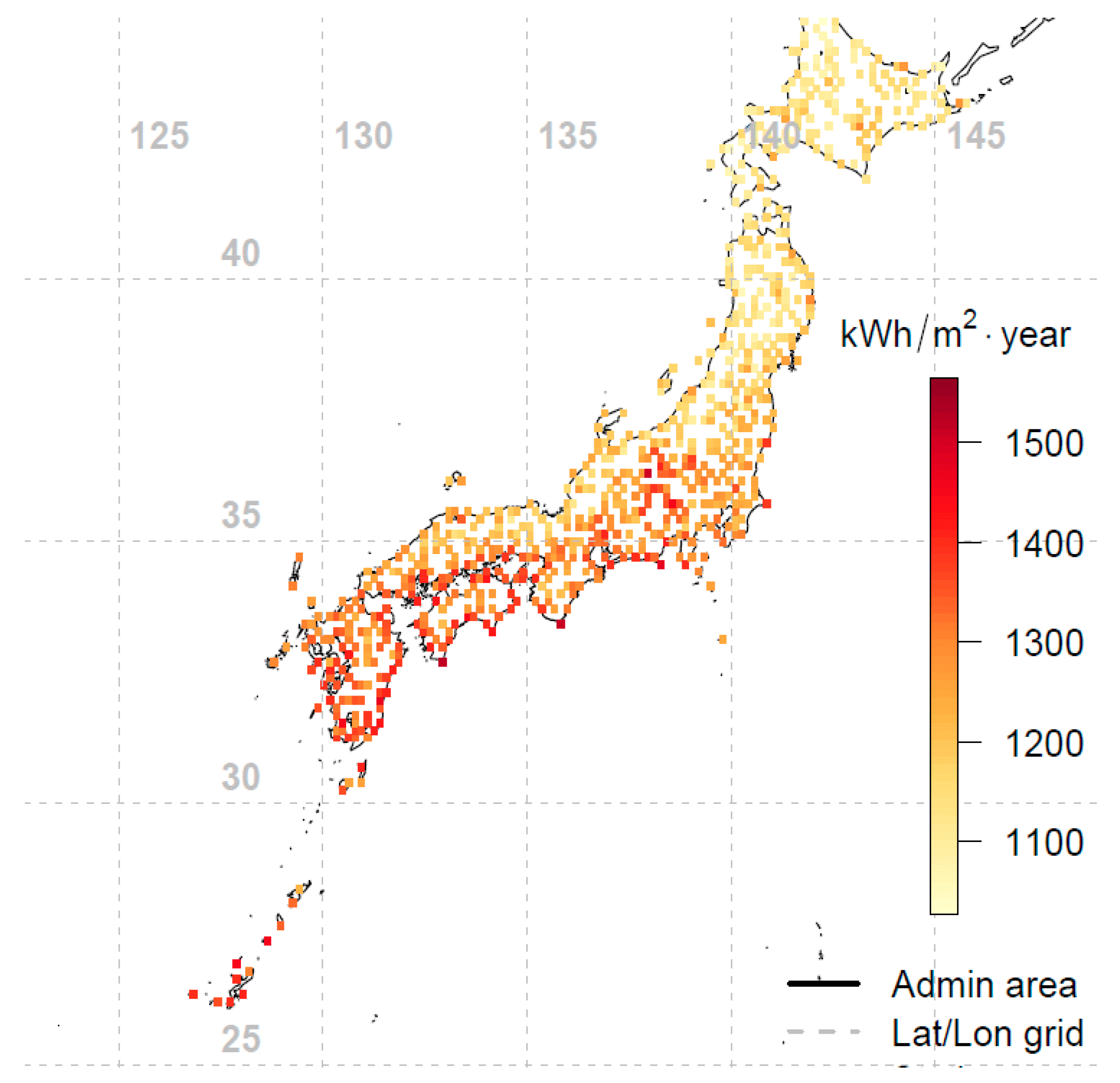
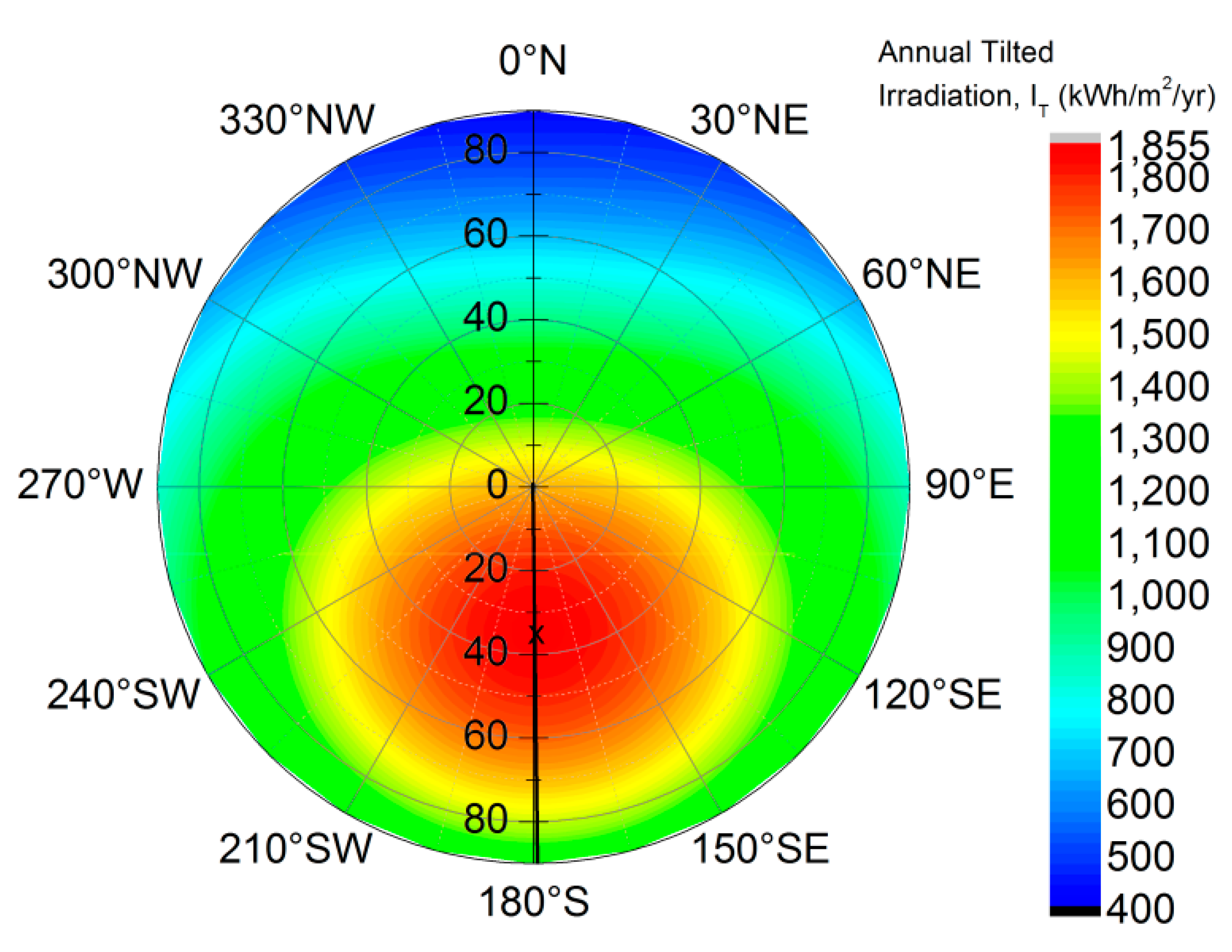
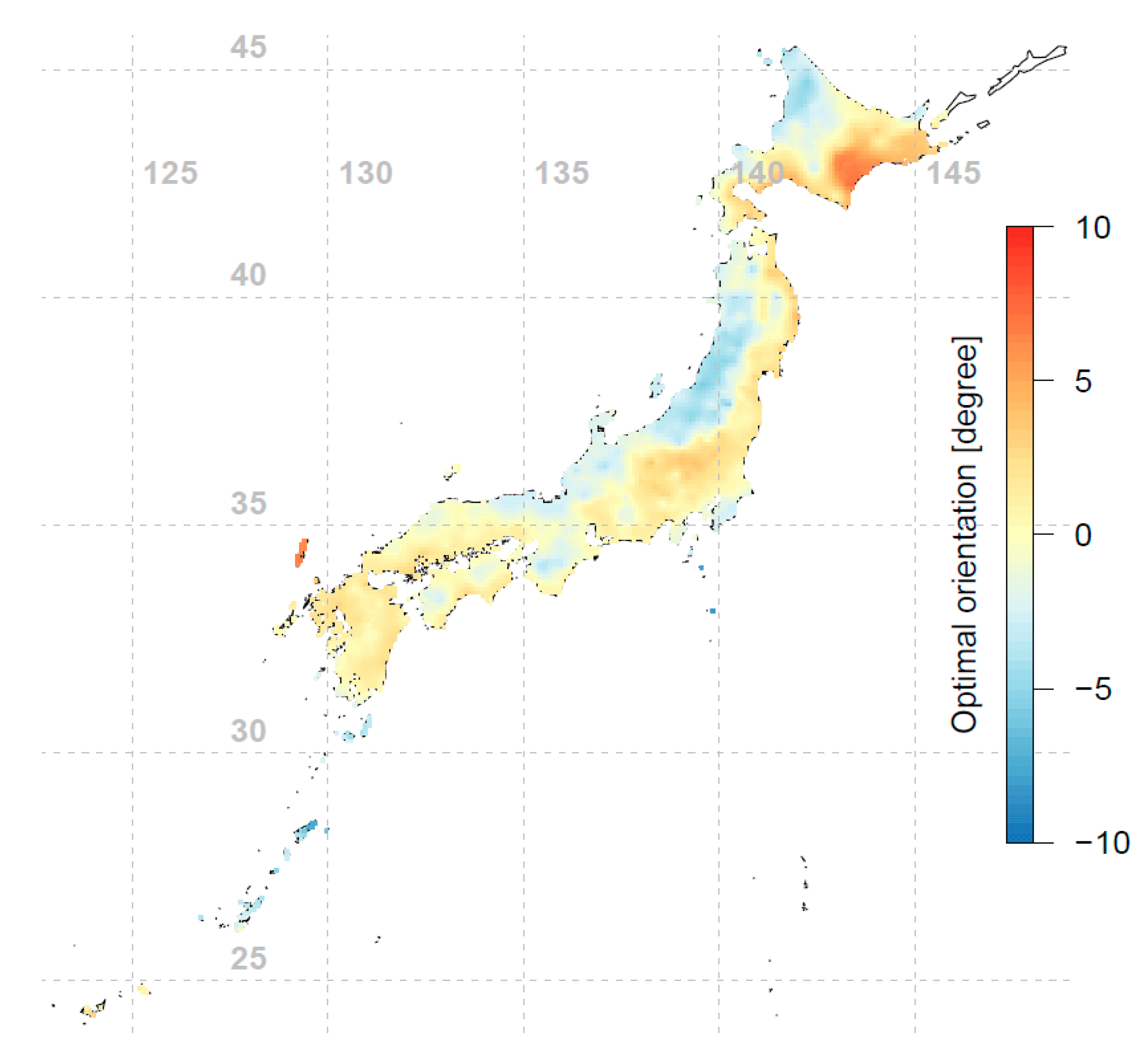
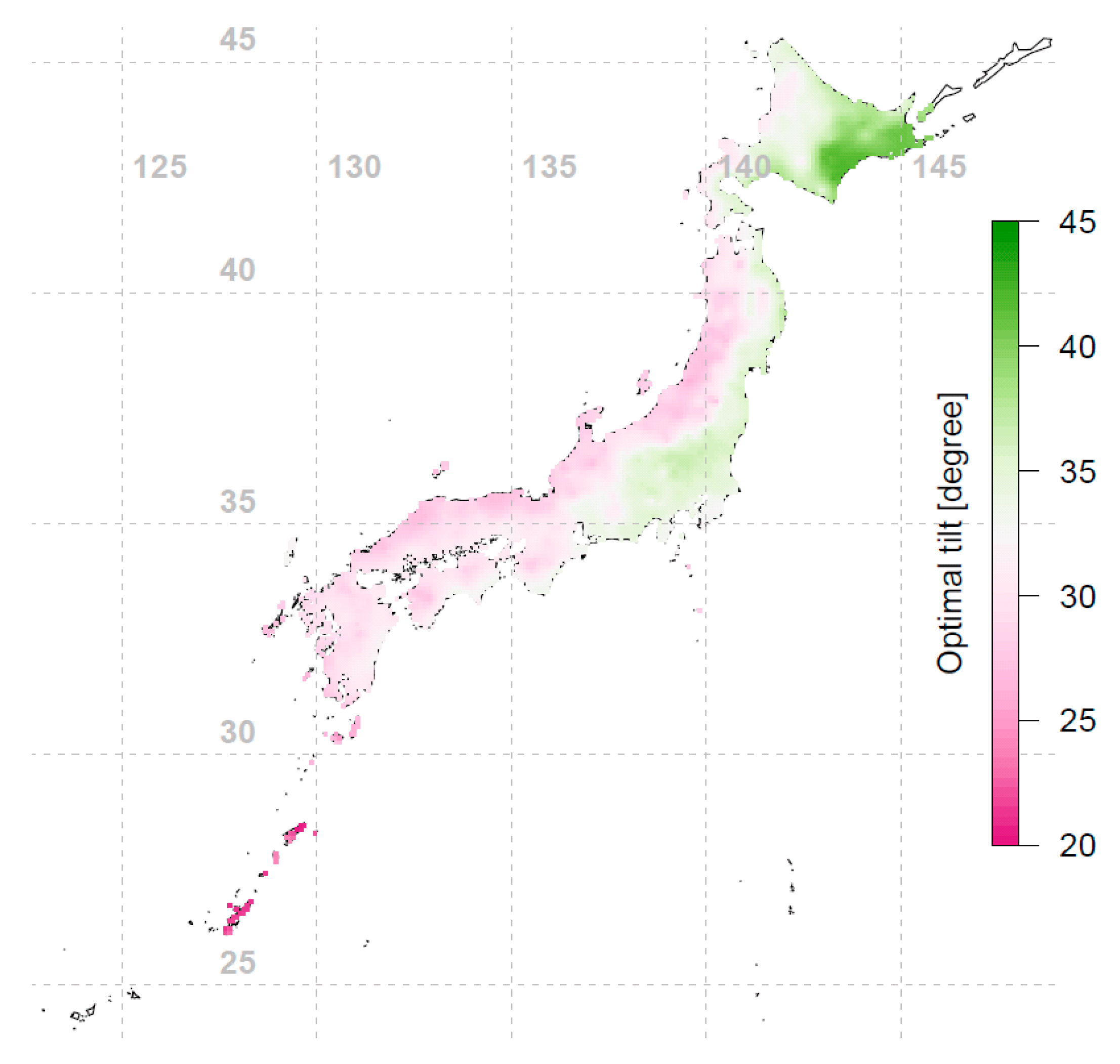
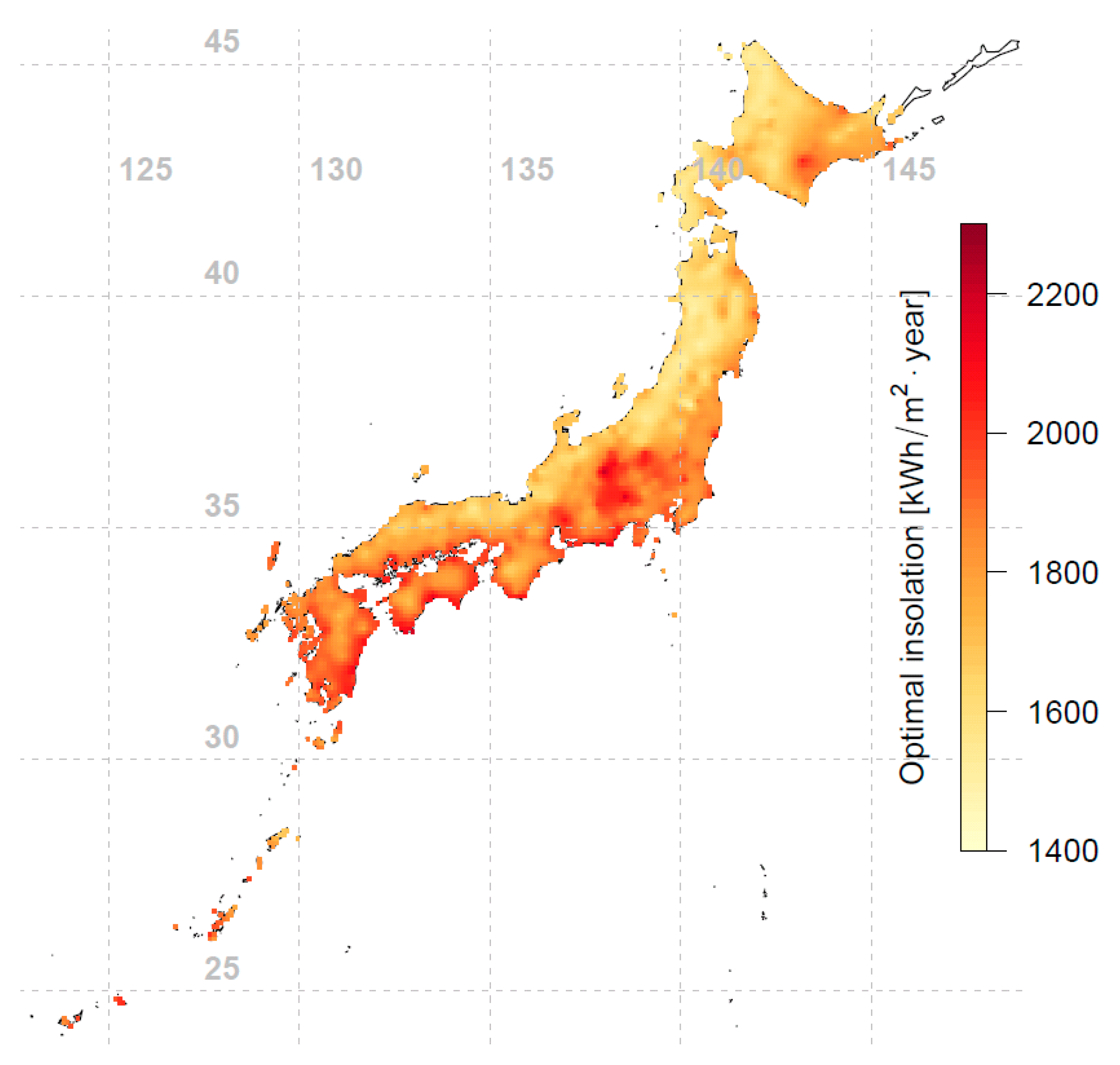
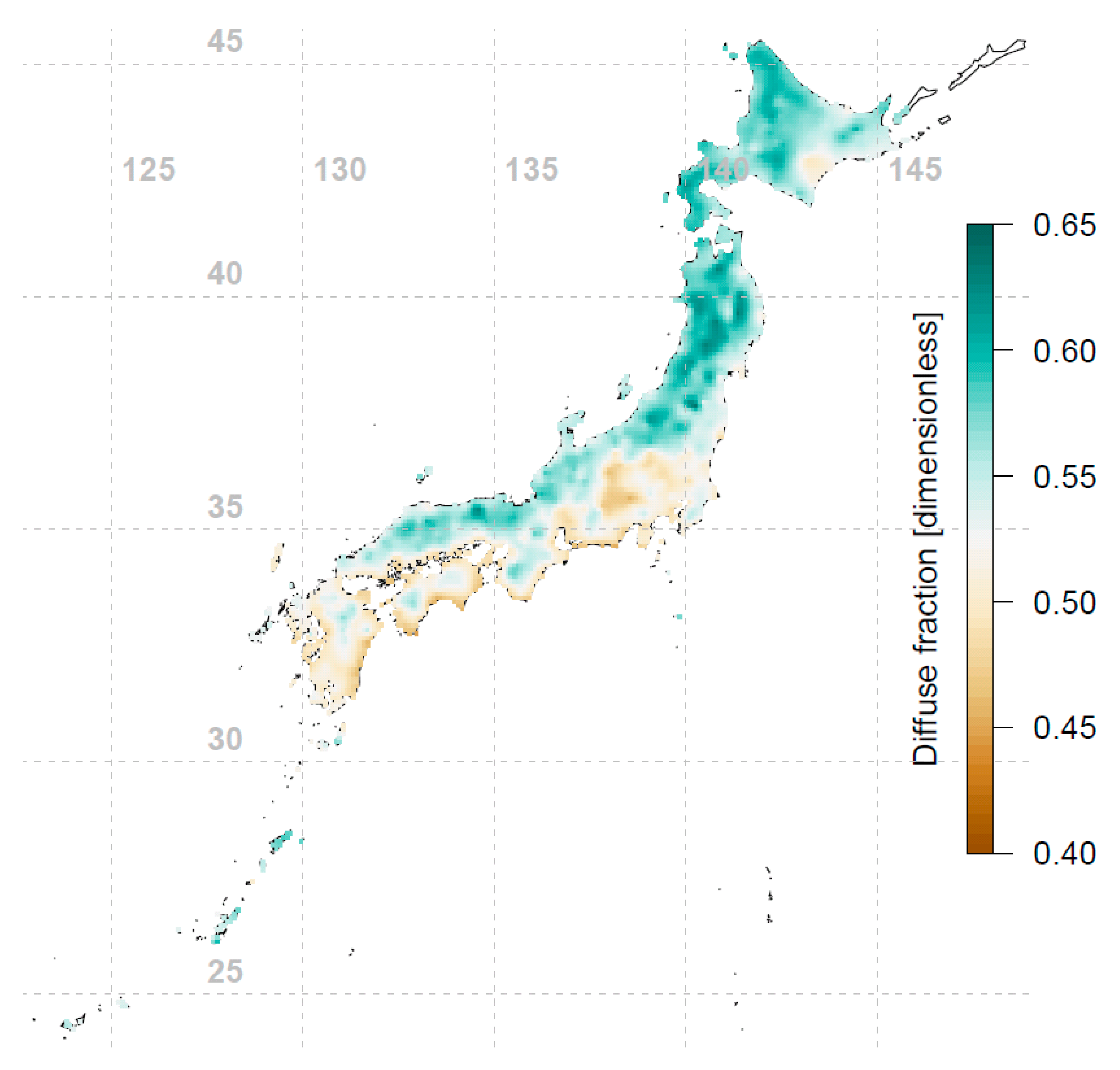

© 2019 by the authors. Licensee MDPI, Basel, Switzerland. This article is an open access article distributed under the terms and conditions of the Creative Commons Attribution (CC BY) license (http://creativecommons.org/licenses/by/4.0/).
Share and Cite
Yu, C.; Khoo, Y.S.; Chai, J.; Han, S.; Yao, J. Optimal Orientation and Tilt Angle for Maximizing in-Plane Solar Irradiation for PV Applications in Japan. Sustainability 2019, 11, 2016. https://doi.org/10.3390/su11072016
Yu C, Khoo YS, Chai J, Han S, Yao J. Optimal Orientation and Tilt Angle for Maximizing in-Plane Solar Irradiation for PV Applications in Japan. Sustainability. 2019; 11(7):2016. https://doi.org/10.3390/su11072016
Chicago/Turabian StyleYu, Cao, Yong Sheng Khoo, Jing Chai, Shuwei Han, and Jianxi Yao. 2019. "Optimal Orientation and Tilt Angle for Maximizing in-Plane Solar Irradiation for PV Applications in Japan" Sustainability 11, no. 7: 2016. https://doi.org/10.3390/su11072016
APA StyleYu, C., Khoo, Y. S., Chai, J., Han, S., & Yao, J. (2019). Optimal Orientation and Tilt Angle for Maximizing in-Plane Solar Irradiation for PV Applications in Japan. Sustainability, 11(7), 2016. https://doi.org/10.3390/su11072016




